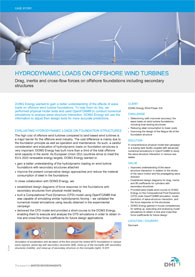 DONG Energy has built more than a third of the total offshore wind capacity in the world. As European Union (EU) countries strive to meet the EU’s 2020 renewable energy targets, DONG Energy, wanted to:
DONG Energy has built more than a third of the total offshore wind capacity in the world. As European Union (EU) countries strive to meet the EU’s 2020 renewable energy targets, DONG Energy, wanted to:
- gain a better understanding of the hydrodynamic loading on wind turbine foundations with secondary structures attached
- improve the present conservative design approaches and reduce the material consumption of steel in the foundations
This project required the establishment of a robust, consistent, and validated experimental physical model setup. We executed an extensive experimental campaign that comprised wave loads on the model cylinders with secondary structures for several foundation types including:
- monopile with and without secondary boat landing structures
- jacket with and without boat landing structures
The experimental programme encompassed various environmental conditions that:
- matched the sea states experienced in practice
- took into consideration the orientation of the WTG foundation structures relative to the stroke of the wave motion and the main wave direction
Next, we utilised the knowledge and results obtained from the experimental programme and put them into a numerical framework. A Computational Fluid Dynamics (CFD) model in OpenFOAM® was setup to accurately simulate the oscillating flow around the structural elements and consecutively produce the integrated time series of force responses on the wind turbine generator (WTG) foundation structures.
The results from the numerical CFD simulation agreed well with the results from the physical model setup. This enabled us to validate the numerical model, which could be used to broaden the range of results from the parametric experimental programme and in the future design of offshore WTG foundations.
The experimental tests, CFD simulations, and a short-course we provided enabled DONG Energy to investigate flow under well-defined conditions. This information helped them understand how present design tools should be adjusted or replaced in order to more accurately predict in-situ loads and support the evaluation of the fatigue design life of foundation structures.